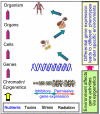Gene-environment interactions and epigenetic basis of human diseases
- PMID: 18525104
- PMCID: PMC2434999
Gene-environment interactions and epigenetic basis of human diseases
Abstract
Most human diseases are related in some way to the loss or gain in gene functions. Regulation of gene expression is a complex process. In addition to genetic mechanisms, epigenetic causes are gaining new perspectives in human diseases related to gene deregulation. Most eukaryotic genes are packed into chromatin structures, which lead to high condensations of the genes that require dynamic chromatin remodeling processes to facilitate their transcription. DNA methylation and histone modifications represent two of the major chromatin remodeling processes. They also serve to integrate environmental signals for the cells to modulate the functional output of their genome. Complex human diseases such as cancer and type 2 diabetes are believed to have a strong environmental component in addition to genetic causes. Aberrancies in chromatin remodeling are associated with both genetically and environmentally-related diseases. We will focus on recent findings of the epigenetic basis of human metabolic disorders to facilitate further exploration of epigenetic mechanisms and better understandings of the molecular cues underlying such complex diseases.
Figures


References
-
- Aerts L, Van Assche FA. Animal evidence for the transgenerational development of diabetes mellitus. Int J Biochem Cell Biol. 2006;38:894–903. - PubMed
-
- Anway MD, Skinner MK. Epigenetic transgenerational actions of endocrine disruptors. Endocrinology. 2006;147:S43–49. - PubMed
-
- Bachman KE, Park BH, Rhee I, Rajagopalan H, Herman JG, Baylin SB, Kinzler KW, Vogelstein B. Histone modifications and silencing prior to DNA methylation of a tumor suppressor gene. Cancer Cell. 2003;3:89–95. - PubMed
Publication types
MeSH terms
Grants and funding
LinkOut - more resources
Full Text Sources
Medical

